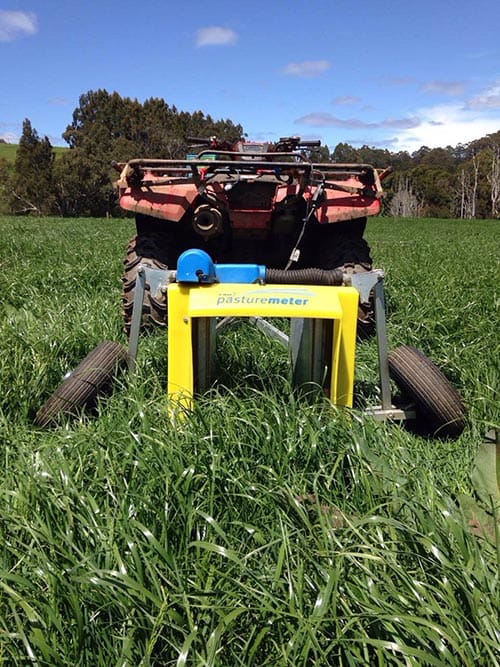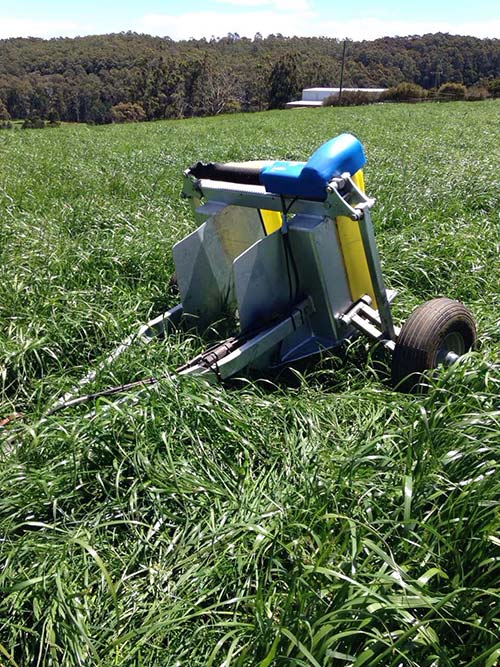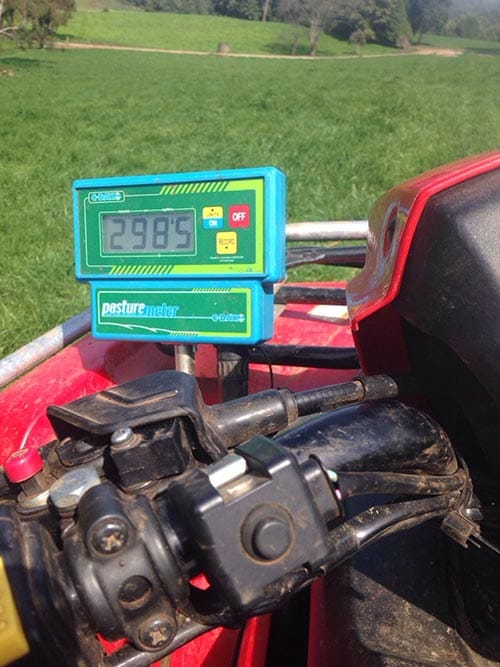As a progressive livestock farmer, we know that you are looking to make improvements continuously. You are always finding ways to improve cattle health.
You have invested in technology to measure milk outputs. And you already understand the importance of managing your pasture fields.
The simplest way to measure and manage your pasture range is to use a rising plate meter (RPM). You might have read our article – "Why you should stop using an RPM." And you are probably looking to invest in a better tool to measure pasture growth quickly.
Welcome, you are in the right place. The C-Dax pasture meter is the next tool for you to consider. In this article, let us talk about the pros and cons of using a C-Dax pasture meter.
First, let us understand how the C-Dax pasture meter works
The C-Dax pasture meter has a series of 18 infrared light emitters and receivers. They are capable of detecting pasture growth in 20 mm increments. The C-Dax needs to be attached to the tow ball of a terrain vehicle (ATV) or a tractor and dragged across paddocks. The C-Dax will measure the height of grass with its infrared sensors. On average, the C-Dax takes about 200 such measurements per second across the paddock area. The average pasture growth across each paddock is then computed. This reading will be used in a formula to gives us the final biomass availability reading in the paddock – in terms of kilograms of dry matter available per hectare (Kg DM/ha).

C-Dax pasture meters are faster and more accurate than RPMs
Product specifications tell us that the C-Dax can be driven by farmers at a maximum speed of up to 20 kph. However, from personal experience, you would typically drive the C-Dax at a much slower pace to get accurate readings. Especially while driving the C-Dax on slopes, rocky terrain, or paddocks with a lot of grass. Otherwise, because of the bumpy ride, at times, the C-Dax might be air-borne. This can affect measurement accuracy. However, the C-Dax still has the advantage of taking thousands of readings and averaging out the differences, but why take the chance? And what if you end up damaging the C-Dax by driving it at top speed? The product offers no warranty against physical damage. The product manual also explicitly instructs the user to avoid damage at any cost.
Even at a slower speed, the C-Dax helps you get accurate pasture growth readings in one or two hours. Thus offering considerable time savings, as the C-Dax takes only about one-third the time it will take to do the same job with an RPM.
The C-Dax also helps you take over 18,500 readings over a single 500m pass across a paddock. Compared to the 60 or so readings taken by an RPM across the same area; it is a huge improvement. Without a doubt, you get more accurate pasture growth readings with a C-Dax.
C-Dax pasture meters can measure pasture growth accurately in ideal conditions
More accurate results with the same driver:
Product specifications tell us that the C-Dax can give you accurate readings independent of the user. However, from personal experience, we think that the same person should use the C-Dax every time. Mainly to maintain accuracy, because, the C-Dax can lose accuracy when driven at different speeds, across the paddock. And secondly, with the same driver, there is a better chance of following a similar path every time, as well as avoiding hard-rocky surfaces or uncharacteristic parts of the paddock.
More accurate results on a clear day:
On a rainy or foggy day, there can be a lot of moisture or dew in your pasture. Using the C-Dax in these conditions can mean that the rain or fog can interfere with the infrared sensors and result in less accurate readings. For the same reason, dust or smog can also result in less accurate readings. The more recent C-Dax models come with a clear plastic housing to avoid this problem. However, the housing still needs to be kept clean for the best results. You get the most accurate results with the C-Dax on a clear day.
C-Dax pasture meters need a human to measure pasture growth regularly
You need a human to use the C-Dax; someone has to make grazing plans and maintain measuring schedules. Someone still has to take out the C-Dax, adjust the angle of the sled if needed, and check tire pressures. Someone has to change its wheels between the device’s transport and measurement positions. Someone has to drive the C-Dax around paddocks and ensure that the readings are taken. Someone has to upload the data on to a Windows PC and analyze the readings. And someone has to keep check of device wear and tear as well as store it away safely. However, this is still significantly lesser work when compared to measuring pasture growth with RPMs.
Also, while driving the C-Dax around a farm, you might need to lift the C-Dax from time to time. Mainly, to prevent damage while crossing farm gates, elevated farm roads or rocky patches. To do this, you will need to get down from your vehicle and manually lift the device. This can be a big problem. Big enough that C-Dax now makes a more advanced (expensive) model with a built-in automatic forklift.

C-Dax pasture meters can measure pasture growth digitally, but not conveniently
You have to create a farm map and follow a set of instructions:
To map your C-Dax pasture growth measurements with paddocks on your farm, you need to follow a specific set of instructions. These instructions include installing some proprietary software, installing Bluetooth drivers, and creating a farm map. By creating a farm map, you can manually assign paddock identifiers to each part of your farm. This setup can take about an hour, depending on how big your farm is.
Once this initial setup is complete, you will need to use these unique paddock IDs every time you take C-Dax readings in that paddock. This will help you automatically transfer the readings from your paddocks on to your PC. It helps you get rid of manual paper and pen-based readings.
C-Dax only syncs with a Windows PC:
However, this requires you to sync the C-Dax device with a Windows PC every time you need to transfer data to your computer. It also means that you cannot do this on any other device such as your smartphone or an Apple device. For most people, this is not going to be a problem. However, this can be limiting for someone who manages a large farm and wants some critical information instantly on their phone, especially when they want to make a grazing decision.
You might have to buy additional upgrades for more advanced stuff:
C-Dax has launched a new range of smart consoles with their XC1 and XP1 products. These devices can help you record data via GPS placement and then transmit them wirelessly to the C-Dax software. Thus eliminating the cumbersome activity of entering paddock IDs and mapping them with on-ground readings. The consoles can additionally also help you calculate how much seed and fertilizer you will need for each paddock. This might be useful, especially if you own other C-Dax products such as the C-DIT 400 & C-DIT 1300 spreaders.

C-Dax pasture meters cannot measure pasture growth cheaply or for free
Cost of the device and additional upgrades:
The basic C-Dax pasture meter costs around AUD 5,000 plus tax. The Auto lift kit will cost you an additional AUD 860 plus tax. The GPS technology-enabled smart console model will cost you AUD 6,990 plus tax.
Cost of farm labour:
As discussed earlier, you need a human to operate the C-Dax and make use of its pasture growth measurements. The associated labor costs can quickly add up. Especially in Australia and New Zealand, where it is hard to find reliable farm labor. C-Dax also recognizes labor costs as a big problem. This is why they are now building prototypes of automated bots to operate the pasture meter without humans.
Cost of C-Dax maintenance:
Like any other machine with moving parts, the C-Dax is also subject to deterioration due to wear and tear. There is always going to be an associated maintenance cost. This is often not considered by farmers when they make the purchase. C-Dax parts are available and this is telling!
The C-Dax cannot help you take effective grazing decisions. It doesn’t analyze weather or your farm’s grazing needs.
C-Dax pasture meters cannot help you take effective grazing decisions
Most importantly, the C-Dax cannot help you make effective grazing decisions after analyzing your pasture growth, local weather forecast, and your farm’s grazing needs. A C-Dax simply cannot do this because; it cannot help you get grazing suggestions on a daily and weekly basis on your smartphone when you are on your farm in the middle of the day. Because it cannot help you cost-effectively measure pasture growth, without spending on hardware, labour, and maintenance. Because it cannot help you measure pasture growth automatically.
In saying all of that, C-Dax Ltd (based in New Zealand) make some awesome products such as the C-Dax Spreader and the C-Dax Sprayer.
However, if these are your needs, you will love pasture.io. We are building a product that puts your pasture growth measurements on autopilot. Thus allowing you to make accurate grazing decisions, improve farm productivity, and earn more profits.
Please check out our free and paid plans. It might change your life and your pasture for the better.
Happy farming!
- The Dedicated Team of Pasture.io, 2019-12-24